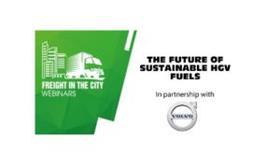
With governments around the world looking to hit tough carbon-cutting targets, there’s no way that future-looking vehicle manufacturers can afford to be anything but ambitious.
Unsurprisingly, John Comer, Volvo Trucks UK head of product management, outlined Volvo’s plans to deliver a 50% cut in its trucks’ CO2 emissions by 2030, and make its entire product range fossil-free by 2040.

Speaking at a Freight in the City webinar, he said innovations such as I-Save, Volvo’s kinetic energy recovery system, along with low rolling resistance tyres, FuelSave and predictive cruise control have already helped Volvo cut CO2 emissions on its baseline trucks by 18.9%.
The OEM also offers a range of alternatively fuelled vehicles, from the recently launched 26 tonne FE City Truck for urban deliveries, to HVO and LNG-powered Volvo trucks for long-haul routes and the recently launched Volvo FM, FH and FMX electric vehicles.
The OEM’s LNG-fuelled trucks are invaluable as an interim technology and increasingly popular, with 770 gas-powered Volvo trucks on the road, partly thanks to the benefit of the tax incentive on natural gas which runs until 2032, Comer said.
Volvo is also working with Daimler to produce a hydrogen fuel cell for the market by 2025, he added.
Taking charge
Adrian Felton, Swarco Evolt national strategic account manager for eTruck and eBus, told attendees the company, which provides charging solutions and aftermarket support for the heavy-duty market, is seeing growing demand for faster DC charging.
Infrastructure projects can be challenging and involve many partners, Felton said. “Collaboration truly is the key. I’ve worked on five big electrification projects and can tell you that no one partner alone can deliver the project.”
Operators play a pivotal role, he added: “They’re the driving factor, we have to have operators that are willing, and on board with this, to really show how innovation can work.”
Felton said one of Swarco Evolt’s future goals is to develop a highly connected charging infrastructure. “If we could get the bus or the truck to talk to the charger, we would know whether it had enough energy to fulfill its next route. Then if the charger could talk to the traffic system, and we knew that a truck or bus had a very low state of charge, then we could even prioritise that vehicle’s movement through the city. So it really does become an ecosystem that fully supports the introduction of electric vehicles.”
Alternative approach
Jonathan Chadburn, vice-president of asset management at DHL Supply Chain, said DHL is striving to cut its logistics-related emissions to net zero by 2050 and increase the carbon efficiency of its own and its subcontractors’ fleets by over 50%, by 2025, compared with 2007 levels. “We’re continually looking at ways to decarbonise through operational efficiencies, as well as via vehicle and trailer design,” he said.
Other strategies include using solar panels on trailers, regularly refreshing the fleet, boosting its electric van fleet and launching DHL’s first 16 tonne all-electric HGV last year. Chadburn said DHL has chosen gas-powered trucks as its interim technology.
“We plan to accelerate uptake across the fleet until 2025, which is effectively DHL’s next investment cycle. The new generation of gas vehicles can deliver 10% to 20% reduction on fossil gas, and up to 80% in CO2 reduction on biomethane,” he explained.
However, he warned that the gas refuelling infrastructure, which recently saw BOC and Calor Gas close down stations, still poses a major challenge.
Chadburn also called for government to harmonise the “disaggregated, fragmented nature of the legislation”.
He also urged government to secure long-term support. Pointing to government plans to review the tax cut on natural gas in 2024, he said: “These are long-term investment decisions, and we need some certainty.”
The three speakers also fielded a range of questions from attendees, from driver training, charging infrastructure capacity, installation costs and green hydrogen, which can all be heard here.










